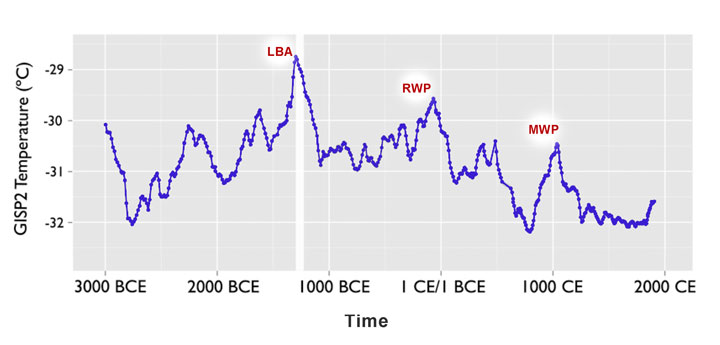Volume 15, Number 40: 3 October 2012
While perusing a paper recently published in the Journal of Archaeological Science (Drake, 2012), we read the author's account of how most of the Greek palatial centers of the Late Bronze Age were either destroyed or abandoned between the 13th and 11th centuries BCE, and how thereafter - during what has come to be known as the Greek Dark Ages - the people affected by this climatic cooling suffered significantly in multiple ways until the advent of the Roman Warm Period.
But that is not what this editorial is about. What we found to be of most interest is something that has been known (by us and many others) about earth's climate for quite some time now; and that is the long-term temperature record produced by the Greenland Ice Sheet Project (GISP2), which is depicted below, as plotted by Drake but based on data reported by Alley (2004).

Figure 1. The past 5,000 years of the GISP2 temperature history of the Greenland Ice Sheet, adapted from Drake (2012), who denoted the general locations of the Late Bronze Age (LBA), the Roman Warm Period (RWP) and the Medieval Warm Period (MWP) in their original work.
In viewing this history, it is most interesting to note (and know) that over its first 4,800 years (that's 96% of the record) - when the temperature varied all over the place - the atmosphere's CO2 concentration was extremely stable, hovering between about 275 and 285 ppm; while over the last 200 years (the remaining 4% of the record), when the temperature shows but a fraction of a degree warming, the air's CO2 concentration rose by well over an extra 100 ppm.
Clearly, the air's CO2 content is not a major driver of earth's temperature. In fact, it may not even be a minor driver.
Sherwood, Keith and Craig Idso
References
Alley, R.B. 2004. GISP2 Ice Core Temperature and Accumulation Data. In: Data Contribution Series #2004-013. NOAA/NGDC Paleoclimatology Program. IGBP PAGES World Data Center for Paleoclimatology, Boulder, Colorado, USA.
Drake, B.L. 2012. The influence of climatic change on the Late Bronze Age Collapse and the Greek Dark Ages. Journal of Archaeological Science 39: 1862-1870.




